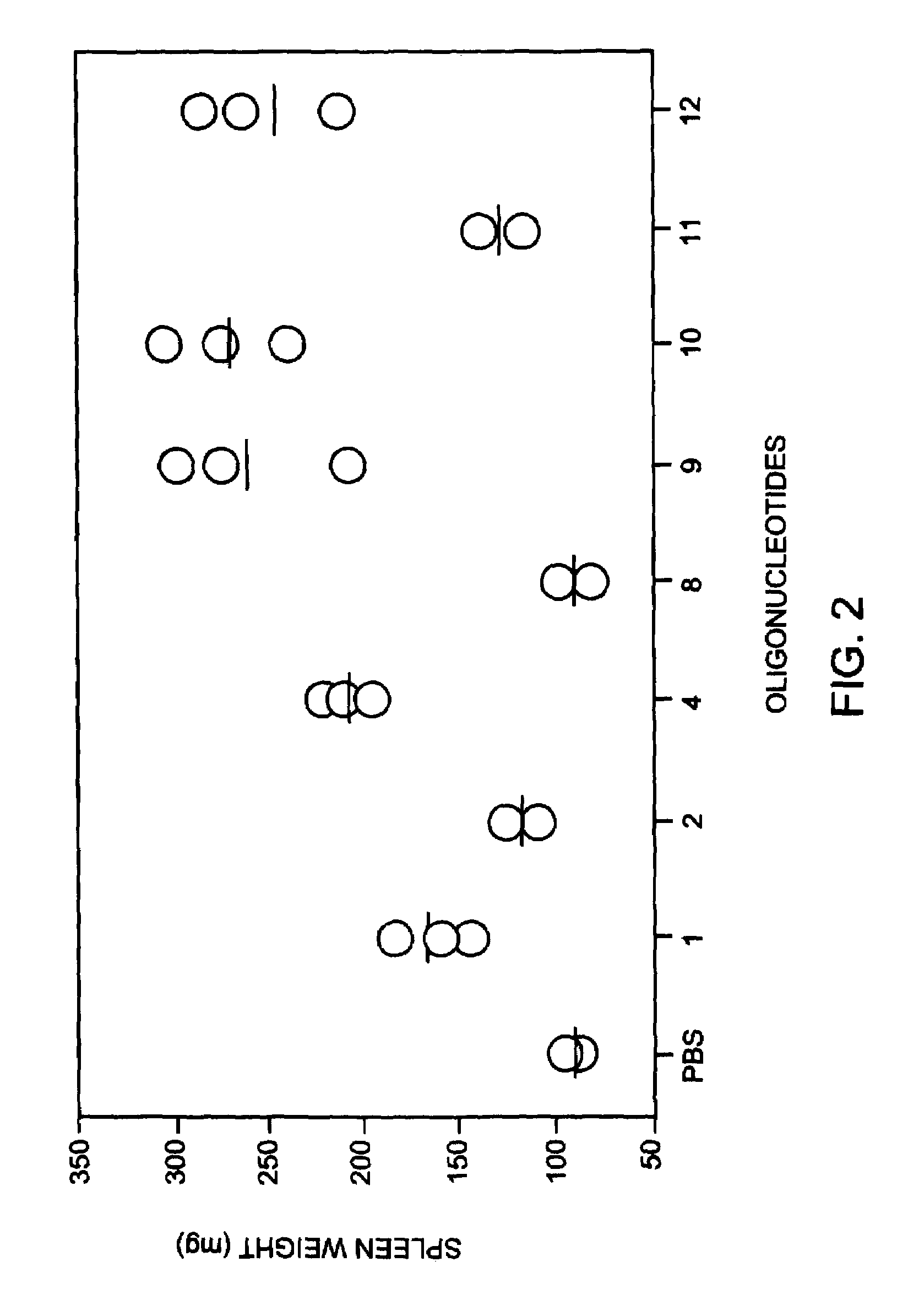Modulation of oligonucleotide CpG-mediated immune stimulation by positional modification of nucleosides
a technology of nucleosides and oligonucleotides, which is applied in the field of therapeutic use of oligonucleotides, can solve the problems of complicated picture of phosphorothioate oligonucleotides, the use of phosphorothioate oligonucleotides is more complex than originally expected, and achieves the effect of increasing the immunostimulatory effect of a cpg-containing oligonucleo
- Summary
- Abstract
- Description
- Claims
- Application Information
AI Technical Summary
Benefits of technology
Problems solved by technology
Method used
Image
Examples
example 1
Preparation of Oligonucleotides Containing Site-specific 3′-O-methylribonucleosides
[0085]Oligonucleotides were synthesized using solid phase (1 μmole scale) phosphoramidite chemistry on an automated DNA synthesizer (Expedite 8909, PE Biosystems, MA). The segment of 3′-O-methylribonucleoside phosphorothioate was incorporated into the oligonucleotide using 3′-O-methyl-2′-cyanoethyl ribonucleoside phosphoramidites (ChemGenes, MA). Oligonucleotide was sulfurized using 3H-1,2-benzodithiole-3-one-1,1-dioxide. Oligonucleotides were purified by preparative reversed-phase HPLC and characterized by CGE (data process through PE Nelson Turbochrom software) and MALDI-TOF mass analysis (Bruker Profelx III mass spectrometer).
example 2
Modulation of Immulostimulatory Effect In Vitro: 3′ Substitutions
[0086]To evaluate the immunostimulatory activity of oligonucleotides in the present study, we have used a mouse spleen cell proliferation assay, as described in Example 1. The oligos shown in Table 1 were used for these studies (SEQ ID NOS 1-5).
[0087]
TABLE 1Oligo No.Sequence and Modification1T C C A T G A C G T T C C T G A T G C2T C C A T G A C G T T C C T G A T G C3T C C A U G A C G T T C C T G A T G C4T C C A T G A C G T T C C T G A T G C5T C C A T G A C G U T C C T G A T G CBold lettering indicates 3′-O-methyl modification
[0088]We used a PS-olgonucleotide containing a single CpG dinucleotide (Oligo 1) and Oligos 2-5 in which substitution of one or two deoxynucleosides was carried out with modified nucleosides at specific sites.
[0089]Substitution with 3′-O-methyl ribonucleosides in Oligos 2-5 simultaneously led to incorporation of 2′-5′ internucleoside linkages. Substitution 5′ of the CpG with no intervening nucleosi...
example 3
Modulation of Immulostimulatory Effect In Vivo: Methylphosphonate Substitutions
[0090]To test the applicability of the in vitro results to an in vivo model, selected oligonucleotides were administered to mice and the degree of splenomegaly was measured as an indicator of the level of immunostimulatory activity. A single dose of 5 mg / kg was administered to Balb / c mice (female, 4-6 weeks old, Harlan Spraque Dawley Inc) intraperitonealy. The mice were sacrificed 72 hours after administration and spleens were harvested and weighed. Positive control Oligo 1 causeda 74% increase in spleen weight compared to negative control mice receiving only PBS.
[0091]Oligonucleotides containing methylphosphonate internucleotide linkages are shown in FIG. 3. Oligonucleotides were prepared having methylphosphonate linkages 3 or 4 nucleotides 5′ to the CpG dinucleotide, or 2 or 3 nucleotides 3′ to the CpG dinucleotide. As shown in FIG. 3, all of these oligonucleotides were more immunostimulatory than Oligo...
PUM
| Property | Measurement | Unit |
|---|---|---|
| Length | aaaaa | aaaaa |
| Length | aaaaa | aaaaa |
| Length | aaaaa | aaaaa |
Abstract
Description
Claims
Application Information
 Login to View More
Login to View More - R&D
- Intellectual Property
- Life Sciences
- Materials
- Tech Scout
- Unparalleled Data Quality
- Higher Quality Content
- 60% Fewer Hallucinations
Browse by: Latest US Patents, China's latest patents, Technical Efficacy Thesaurus, Application Domain, Technology Topic, Popular Technical Reports.
© 2025 PatSnap. All rights reserved.Legal|Privacy policy|Modern Slavery Act Transparency Statement|Sitemap|About US| Contact US: help@patsnap.com



